

About Japanese Swordsmanship Shinkendo
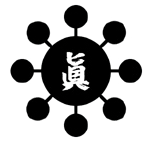 Study of Japanese Swordsmanship has become very popular in the twenty-first century, but qualified schools and instructors are rare. Many people do not know where to look, or even what to look for, when considering instruction in Japanese Swordsmanship. This page is intended to provide basic information about the history of this great art, and how it can best be studied today through Shinkendo, the Way of the Real Sword.
Study of Japanese Swordsmanship has become very popular in the twenty-first century, but qualified schools and instructors are rare. Many people do not know where to look, or even what to look for, when considering instruction in Japanese Swordsmanship. This page is intended to provide basic information about the history of this great art, and how it can best be studied today through Shinkendo, the Way of the Real Sword.
History of Japanese Swordsmanship
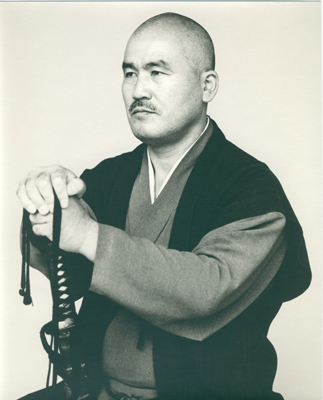 The history of the hei (army) is very long, but the history of the Samurai or Bushi started 1000 years ago. The schools (Ryuha) that the Samurai trained in have a history of 600 years. As the Japanese society became more peaceful, many people started to pursue a profession of teaching Budo, and many Ryuha were created by incorporating ideas from the battlefields. Different instructors had different training methods, ideas, and different styles of fighting. This eventually led to the split of different styles, leaving categories of styles such as Kenjutsu, Iaijutsu, Battojutsu. In the recent 150 years, these styles have subdivided even further.
The history of the hei (army) is very long, but the history of the Samurai or Bushi started 1000 years ago. The schools (Ryuha) that the Samurai trained in have a history of 600 years. As the Japanese society became more peaceful, many people started to pursue a profession of teaching Budo, and many Ryuha were created by incorporating ideas from the battlefields. Different instructors had different training methods, ideas, and different styles of fighting. This eventually led to the split of different styles, leaving categories of styles such as Kenjutsu, Iaijutsu, Battojutsu. In the recent 150 years, these styles have subdivided even further.
Each Ryuha has its own history. The people that teach the style have a duty of not changing techniques, training methods, and ideals. To change an ideal or technique while under the name of a Ryuha is disrespectful and disloyal to the original founder and Ryuha. Therefore, the different Ryuha cannot merge and combine as one, and it is important to “protect” each style and preserve its original form by keeping them separate.
The real way of the sword, however, is one that must combine the important aspects of every style. Shinkendo is a modern art, and as such it is able to break down the walls between the different Ryuha and reincorporate their teachings into one comprehensive form. This is the way Japanese swordsmanship was originally studied.
The Study of Japanese Swordsmanship
There are many types of schools where one can study one aspect or another of Japanese Swordsmanship. Only Shinkendo involves study of each of these important aspects of swordsmanship. True, deep study of Japanese Swordsmanship must involve many interlocking concepts. In Shinkendo, these five aspects of swordsmanship, Suburi, Battoho, Tanrengata, Tachiuchi, and Tameshigiri are like five interlocking rings. All five aspects have some relation to the other rings. This is the foundation of a comprehensive study of swordsmanship. It allows for one to view the techniques from a larger perspective and pursue them deeply.
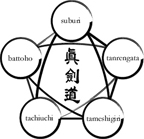 Suburi – Swinging and Basics
Suburi – Swinging and Basics
Battoho – Combative Drawing and Sheathing
Tanrengata – Main Solo Forms
Tachiuchi – Partnered Training
Tameshigiri – Test-Cutting Practice
TACHIUCHI – Partner Exercises
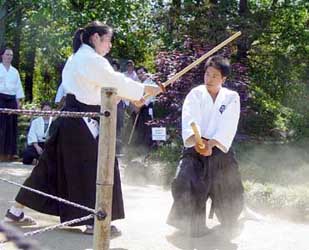 Koryu kenjutsu is a form of partnered training that starts when both participants already have their blades drawn. Many koryu kenjutsu styles still exist in Japan today. Training is usually done with a bokuto (wooden sword), but some styles also use a fukuro-shinai (padded bamboo stick), to practice sparring techniques more safely. The important aspects of koryu kenjutsu are incorporated into Shinkendo as Tachiuchi, or two-person prearranged exercises.
Koryu kenjutsu is a form of partnered training that starts when both participants already have their blades drawn. Many koryu kenjutsu styles still exist in Japan today. Training is usually done with a bokuto (wooden sword), but some styles also use a fukuro-shinai (padded bamboo stick), to practice sparring techniques more safely. The important aspects of koryu kenjutsu are incorporated into Shinkendo as Tachiuchi, or two-person prearranged exercises.
Kendo is a form of sparring that utilizes bogu (armor) and practice with a shinai (bamboo sword), that came into existence near the end of the Edo period. After WWII, modern kendo became more of a competition sport of hitting and thrusting, rather than true Budo. However, those valuable sparring tactics that are used in Kendo are incorporated into Shinkendo as variations in Tachiuchi.
BATTOHO – Drawing and Sheathing Methods
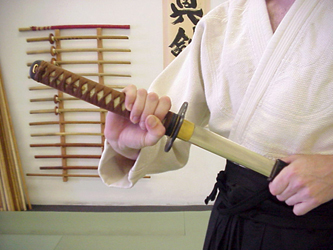 Shinkendo teaches how to draw the sword combatively, and re-sheath it safely. This training is called Battoho. Students begin practice with a wooden sword and learn to draw effectively in many directions. Advanced students later use an Iaito, or non-sharpened practice sword, and later use a Shinken, or real sword.
Shinkendo teaches how to draw the sword combatively, and re-sheath it safely. This training is called Battoho. Students begin practice with a wooden sword and learn to draw effectively in many directions. Advanced students later use an Iaito, or non-sharpened practice sword, and later use a Shinken, or real sword.
Techniques done from a sitting position (Suwari Iai) are very common in other schools, but are not used in Shinkendo. These techniques are impractical and unsafe. Instead, Shinkendo draws are done from the traditional Fudo (standing) or Tachiaigoshi (crouch, or ready stance) positions.
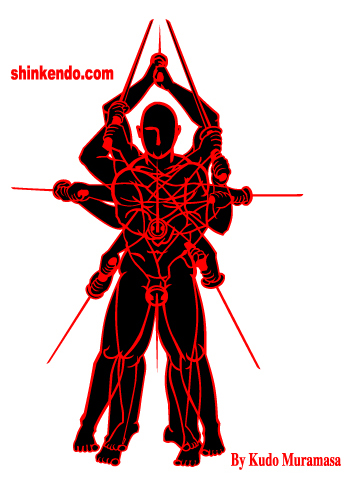 TANREN KATA – Solo Forms
TANREN KATA – Solo Forms
The main solo forms practiced in Shinkendo are called Tanrengata. The term "Tanren" also refers to the process of removing the impurities in metal when forging a sword. Shinkendo kata emphasize fluid movement, graceful balance shifting, and effective body/sword mechanics.
SUBURI – Sword and Body Movement
Suburi means sword swinging practice. In Shinkendo this term is used to define basic sword movements, correct footwork, and body movement practices. These fundamentals are crucial to proper training, and must never be neglected.
TAMESHIGIRI – Test-Cutting
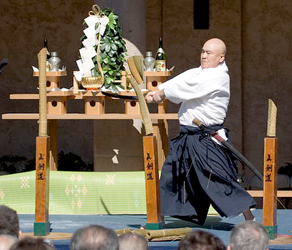 Tameshigiri is the practice of using real swords and target material to test the swordsman's accuracy and form. This requires a great deal of concentration and skill, and is usually done only by well-trained students under direct supervision.
Tameshigiri is the practice of using real swords and target material to test the swordsman's accuracy and form. This requires a great deal of concentration and skill, and is usually done only by well-trained students under direct supervision.
Test-cutting is only one aspect of swordsmanship training, and should not be viewed as the sole purpose of training, or done for entertainment or sport. The practice of cutting inappropriate materials such as fruit, water bottles or other 'circus acts' should be strongly discouraged. Japanese Swordsmanship should always be approached with dignity and sincerity.
The Establishment of Shinkendo
Shinkendo is a form of Budo, or Japanese martial arts, created in 1990 by Obata Toshishiro. Mr. Obata studied and mastered many different schools of Budo in Japan, and then came to America to distill what he had learned into a new, complete art. Shinkendo is the real way of the sword.
Studying true swordsmanship must also include proper philosophies (Kyogi) and techniques (Jitsugi). Shinkendo's philosophies are based on Kuyo Junikun (Nine Planets, 12 Precepts) and Hachido (The Eight-Fold Path). Together, these teachings promote the ideal of Jinsei Shinkendo: to learn valuable lessons from sword study, and incorporate them into our lives in order to live a better lifestyle.
Ranking in Shinkendo is based on the older, traditional system without the usage of the modern Dan and Kyu rankings. Being a great student and being a great instructor are two different things, and therefore student ranks and instructor ranks are tested and awarded separately.
The International Shinkendo Federation was officially established in 1994 in order to spread it to the world. Shinkendo is based on more than a thousand years of Samurai history, and was researched and developed by Obata Toshishiro in order to create a comprehensive style of swordsmanship that could be introduced to the world. Shinkendo is trademarked in the US, Japan, and other countries. The name Shinkendo and Shinkenjutsu are protected, and cannot be used without the authorization of the International Shinkendo Federation.
Anyone seeking instruction in Shinkendo is encouraged to research and locate the nearest officially licensed branch of the International Shinkendo Federation. If you are unsure of someone's official credentials, please do not hesitate to contact the World Headquarters, or Honbu Dojo.
Please direct questions and comments to:
![]()










